Planetizen's annual list of top books covers subjects in all varieties of planning: urban planning, community planning, environmental planning, and more.

The Top 10 Urban Planning Books of 2018
2018 was the strongest year for planning books in recent memory. Famous authors, essential and illuminating stories, and steady clip of strong titles from the publishers most devoted to planning relevant books are just a few of the ways the stars aligned. Books from this year's list of top planning books will be shared and recommended for years to come.
The Big Ones: How Natural Disasters Have Shaped Us (and What We Can Do About Them)
Lucy Jones
Penguin Random House
April 17, 2018, 256 pages
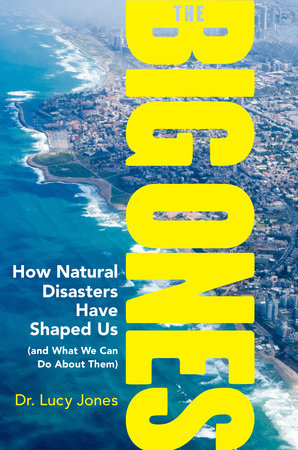 Lucy Jones is as good with a pen as she is with a seismograph. A longtime staffer with the U.S. Geological Survey, Jones is beloved in California for her straight talk about the state's earthquake risks. Jones recently retired from the public sector but has continued her crusade of educating the public about the dangers of disasters (especially earthquakes) and encouraging preparedness in all its forms. For Jones, this doesn't just mean retrofitting buildings and learning how to duck under tables. It includes everything from economic analyses of different scenarios—such as the economic impact of buildings designed to remain functional after a major earthquake versus those designed simply not to fall down immediately—to public awareness campaigns that, ultimately, are intended to pressure governments into taking unpredictable but real threats seriously.
Lucy Jones is as good with a pen as she is with a seismograph. A longtime staffer with the U.S. Geological Survey, Jones is beloved in California for her straight talk about the state's earthquake risks. Jones recently retired from the public sector but has continued her crusade of educating the public about the dangers of disasters (especially earthquakes) and encouraging preparedness in all its forms. For Jones, this doesn't just mean retrofitting buildings and learning how to duck under tables. It includes everything from economic analyses of different scenarios—such as the economic impact of buildings designed to remain functional after a major earthquake versus those designed simply not to fall down immediately—to public awareness campaigns that, ultimately, are intended to pressure governments into taking unpredictable but real threats seriously.
In the Big Ones, with a title derived from the predicted earthquake that will, one day, decimate California, Jones digs into the history of a handful of natural disasters from geological, as well as political, social, and economic, perspectives. What planners glibly refer to as "resilience," Jones understands with nuance and expertise. She covers the 1755 Lisbon earthquake, the 1861 central California flood (really!), Hurricane Katrina, and the Indonesian tsunami, among others, each time telling predictably harrowing tales and making implicit policy recommendations. Indeed, Jones is the rare scientist who grasps policy and prose just as well as she does the technicalities of her field. Jones doesn't tell planers how to do their jobs. But in describing the devastation that Mother Nature can wreak on urban areas, she gives them plenty to think, and worry, about. Buy the book.
Boom Town: The Fantastical Saga of Oklahoma City, its Chaotic Founding...its Purloined Basketball Team, and the Dream of Becoming a World-class Metropolis
Sam Anderson
Penguin Random House
August 21, 2018, 448 pages
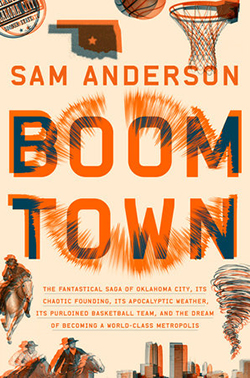 Every city should be so lucky as to have a Sam Anderson in its corner. In the often dull genre of urban biographies, Boom Town is a rollicking, engaging, and occasionally hilarious account of the past and future of Oklahoma City. Anderson alternates between exuberant accounts of the prosperity and awesomeness of contemporary OKC with well researched stories of its history, dating back, of course, to the infamous land rush that created Oklahoma—and displaced Native Americans—by fiat in 1889. Anderson builds on the premise that flat, conservative, distant OKC—the ultimate flyover city in the ultimate flyover state—is far more interesting than coastal elites, including himself, would ever imagine.
Every city should be so lucky as to have a Sam Anderson in its corner. In the often dull genre of urban biographies, Boom Town is a rollicking, engaging, and occasionally hilarious account of the past and future of Oklahoma City. Anderson alternates between exuberant accounts of the prosperity and awesomeness of contemporary OKC with well researched stories of its history, dating back, of course, to the infamous land rush that created Oklahoma—and displaced Native Americans—by fiat in 1889. Anderson builds on the premise that flat, conservative, distant OKC—the ultimate flyover city in the ultimate flyover state—is far more interesting than coastal elites, including himself, would ever imagine.
Anderson describes a city well aware of its faults and also optimistic about its future. As for planning, OKC's low point came, arguably, with its urban renewal plan of the 1950s and '60s. Orchestrated by a young I.M. Pei, OKC's demolition was even more aggressive than that of most other cities that committed partial suicide in the urban renewal era. Add to that the oil bust of the 1970s, various tornadoes, and, of course, the 1994 bombing and you get a city that should be all but dead.
Instead, OKC's boosters, unworried by culture, history, and anyone else's expectations, kept building, kept recruiting, and kept believing until their breakthrough accomplishment: the relocation of the Seattle Supersonics NBA team and their rechristening as the Oklahoma Thunder. It is this that Anderson, himself an accomplished sports journalists, marks as the birth of, as he describes it, one of the country's "great minor cities."
Boom Town raises the question: Why should anyone else care what some journalist says about some random city? Anderson probably could have written (and over-written, as he occasionally does) equally exuberant books about dozens of other places. But the fact is, cities don't often promote themselves. These days, many cities have gotten so caught up in self-flagellation—over, on the one hand, gentrification and housing prices (SF, LA, NYC)—or self-pity over urban decay (the Rust Belt) that they lose sight of the power of genuine love for and promotion of themselves. Planners, who often get bogged down in minutiae and beaten down by stakeholders, are especially guilty of this. Anderson and Boom Town show us how to see a city with fresh eyes. Buy the book.
Building and Dwelling: Ethics for the City
Richard Sennett
Farrar, Straus and Giroux
April 10, 2018, 368 pages
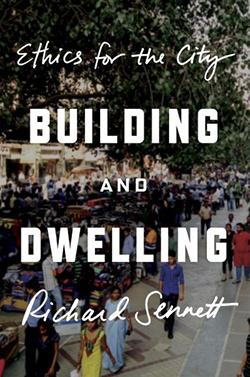 Building and Dwelling, Sennett's 15th book on urbanism, is an intellectual romp that includes encounters with St. Augustine, Honore de Balzac, Marcel Proust, Immanuel Kant, and Nicholas Negroponte; that is just in the first four pages.
Building and Dwelling, Sennett's 15th book on urbanism, is an intellectual romp that includes encounters with St. Augustine, Honore de Balzac, Marcel Proust, Immanuel Kant, and Nicholas Negroponte; that is just in the first four pages.
Sennett uses a compelling framework and aspires to an admirable, if elusive goal. The framework is ville and cite: the former referring to the physical entity of the city, the latter referring to its human element: how people live in, think about, and relate to their cities—hardware and software, for lack of a better metaphor. Sennett's goal is nothing less than an articulation of how to achieve, or at least think about, the ethical city in the 21st century. It's no small task.
City life always wavers along continua that are bounded by unattainable poles. Dualities run throughout Building and Dwelling. Sennett ponders public and private; past and future; formal and informal; technological and analog; freedom and order; surveillance and anonymity; diversity and homogeneity, democracy and despotism; logic and emotion; local and metropolitan; past and future, speed, and incrementalism; and Moses and Jacobs, among many others. He arrives at the idea of an "open city" to express a host of virtues that he believes should permeate the ethical city. Openness entails diversity, neighborliness, evolution, appropriate technology, and novelty.
With a few exceptions, Sennett's book is not a prescription for urban planners. It includes no practical advice and makes virtually no reference to current planning trends, at least not by name. To planners who would reflexively adopt new technologies, Sennett warns, "There is nothing better about the past just because it has already happened. So, too, there is nothing better about the new just because it is unlike the past." Buy the book.
The Design of Childhood: How the Material World Shapes Independent Kids
Alexandra Lange
Bloomsbury Publishing
June 12, 2018, 416 pages
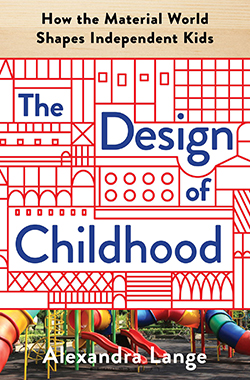 Alexandra Lange wrote the book on architecture criticism, literally, with Writing About Architecture, published by Princeton Architectural Press in 2012. As the architecture critic for the national real estate and planning website Curbed, Lange's position of authority in urbanism media has few, if any, peers. But it's Lange's role as parent that directs The Design of Childhood in providing a history of design thinking related to the daily life of children.
Alexandra Lange wrote the book on architecture criticism, literally, with Writing About Architecture, published by Princeton Architectural Press in 2012. As the architecture critic for the national real estate and planning website Curbed, Lange's position of authority in urbanism media has few, if any, peers. But it's Lange's role as parent that directs The Design of Childhood in providing a history of design thinking related to the daily life of children.
The Design of Childhood is as revelatory with lessons about the history of design as it as with lessons about childhood—and a surprising number of themes emerge as Lange shifts the focus of the discussion from LEGOs and Minecraft to high chairs and the "Whole Family House" to the book's concluding chapter on urban and town planning. The big idea connecting the whole history, however, is for design to once again become a central consideration when thinking about the expanding minds and worlds of children, moving the focus away from constant attention to computer and television screens and out into a world of freedom and creativity. According to Lange, children are citizens, rather than consumers.
Still, there is plenty to learn about consumer goods in the pages of The Design of Childhood, and the book achieves the rare trick of staying relevant and compelling to an audience of planners and urban designers even when the subject ostensibly on matters of smaller scale than what we think of as the built environment. That's the shift in scale the book is asking the reader to make: children think about building blocks before they start thinking about superblocks, but it all matters to the future world, and the people who will live in it. Buy the book.
The Divided City: Poverty and Prosperity in Urban America
Alan Mallach
Island Press
June 2018, 344 pages
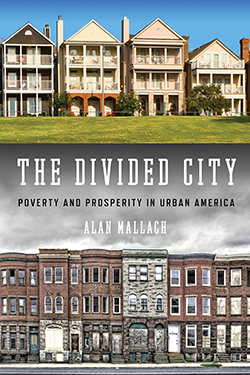 While the rise of America's superstar cities has inspired both excited theorizing ("the creative class!") and reactionary criticism ("gentrification!"), less prosperous cities of the Rust Belt and the East Coast have patiently waited for the sensitive, nuanced, well informed discussion they deserve and need. The Divided City is that discussion. Urban scholar Alan Mallach investigates the decline and rise of cities ranging from Detroit to Cleveland to Buffalo to Baltimore, describing exactly what went wrong and discerning how wrong it went. In many cases, cities that seem like failures aren't nearly as down-and-out as their images would suggest. Mallach covers the major issues: deindustrialization, racism and segregation, investment and disinvestment, vacancy, and, of course, displacement and gentrification. The latter phenomenon he ascribes not to invasion by the haves against the have-nots but rather to "global and national increases in economic inequality, demographic shifts, changes in employment, aging of the urban housing stock, suburban out-migration of middle-class black families, and the continue fallout from the foreclosure crisis." It's nuanced, indeed.
While the rise of America's superstar cities has inspired both excited theorizing ("the creative class!") and reactionary criticism ("gentrification!"), less prosperous cities of the Rust Belt and the East Coast have patiently waited for the sensitive, nuanced, well informed discussion they deserve and need. The Divided City is that discussion. Urban scholar Alan Mallach investigates the decline and rise of cities ranging from Detroit to Cleveland to Buffalo to Baltimore, describing exactly what went wrong and discerning how wrong it went. In many cases, cities that seem like failures aren't nearly as down-and-out as their images would suggest. Mallach covers the major issues: deindustrialization, racism and segregation, investment and disinvestment, vacancy, and, of course, displacement and gentrification. The latter phenomenon he ascribes not to invasion by the haves against the have-nots but rather to "global and national increases in economic inequality, demographic shifts, changes in employment, aging of the urban housing stock, suburban out-migration of middle-class black families, and the continue fallout from the foreclosure crisis." It's nuanced, indeed.
While Mallach is objective, even-handed, and scholarly, he is not distant. He treats cities and their residents sensitively, countering stereotypes and conveying cautious optimism. He is schooled in urban economics and sensitive to the causes of inclusion and equity. As he writes, "these cities matter," he continues, "we need to admire their efforts and celebrate their achievements, but we also need to drill down to understand why, for all their hard work over many decades, things are not getting better." Mallach ultimately argues that the key to reviving America's industrial, legacy cities is not urban renewal, eds and meds, shiny new stadiums, federal programs, or anything else. It is, a little bit of everything—and it requires a great deal of thought and care. On that count, Mallach leads the way. Buy the book.
High-Risers: Cabrini-Green and the Fate of American Public Housing
Ben Austen
Harper Collins Publishers
February 13, 2018, 400 pages
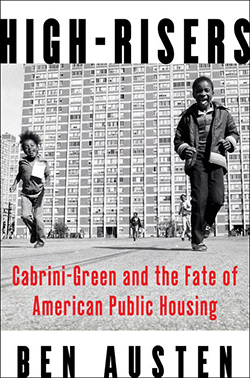 It's hard to imagine a story in American urban planning more depressing than that of the rise and fall of public housing in the 1950s and 1960s. Indeed, High Risers is anything but a fairy tale. But, in sensitively and painstakingly documenting the development, occupation, and infamous demolition of Chicago's Cabrini-Green apartments—prototypical modernist high rises, of the sort that arose in many American cities—Ben Austen adds a human element to an account that typically centers on crime, blight, and misguided architecture and planning. Indeed, Cabrini-Green suffered all of that.
It's hard to imagine a story in American urban planning more depressing than that of the rise and fall of public housing in the 1950s and 1960s. Indeed, High Risers is anything but a fairy tale. But, in sensitively and painstakingly documenting the development, occupation, and infamous demolition of Chicago's Cabrini-Green apartments—prototypical modernist high rises, of the sort that arose in many American cities—Ben Austen adds a human element to an account that typically centers on crime, blight, and misguided architecture and planning. Indeed, Cabrini-Green suffered all of that.
Austen focuses, though, on the people behind the development. He tells stories of residents, community members, and public officials who all tried to make it work and then, once it was beyond salvation, saw to its demolition (a few low-rise units remain). He portrays the relationship between residents and the giant bureaucracies, such as the Department of Housing and Urban Development, that kept roofs over their heads. And he captures the ambivalence of public housing: yes, it was grimy and crime-ridden, but it was also home to many grateful residents. Naturally, most of those residents were African-American, and Austen explores the racial inequities that are nearly synonymous with public housing. High Risers is not a prescription for how planners can re-envision public housing. But it does give them insights and cautionary tales that will, hopefully, serve the next generation of public housing developments and their residents well. Buy the book.
Parking and the City
Donald Shoup
Routledge
April 13, 2018, 534 pages
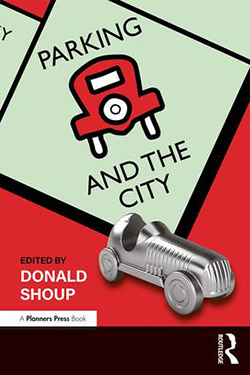 Donald Shoup has already written one of the most influential and consequential books in planning history, The High Cost of Free Parking. Feeding the momentum of Shoup's ongoing influence are a legion of devoted acolytes, known as Shoupistas, and also the continued adoption of the Shoup's suggested reforms by U.S. communities of all shapes, sizes, and geographic orientation.
Donald Shoup has already written one of the most influential and consequential books in planning history, The High Cost of Free Parking. Feeding the momentum of Shoup's ongoing influence are a legion of devoted acolytes, known as Shoupistas, and also the continued adoption of the Shoup's suggested reforms by U.S. communities of all shapes, sizes, and geographic orientation.
Shoup's follow up, Parking in the City, has plenty of new material to work with, just 13 years after the High Cost of Free Parking was first published. In the first of two sections, Shoup writes with unparalleled wit and style on the formerly technocratic matter of parking regulations. In essence, Shoup shapes the 800 pages of The High Cost of Free Parking into an abridged version, which might in the future become the entry point of choice for first-time encounters with parking reform. The second section provides a series of studies and research, edited by Shoup, to update the body of research and scientific inquiry in the realm of parking regulations.
As the book makes perfectly clear, the case for Shoup's three-part prescription for parking woes has only grown stronger since 2005. Shoup's writing is as incisive and entertaining as ever. The imperative of parking reform—in a year of wildfires, floods, and transit systems choking on lack of revenue and riders—has never been clearer. Parking and the City is a perfect follow up to a classic work. Buy the book.
The Poisoned City: Flint's Water and the American Urban Tragedy
Anna Clark
Metropolitan Books
July 10, 2018, 320 pages
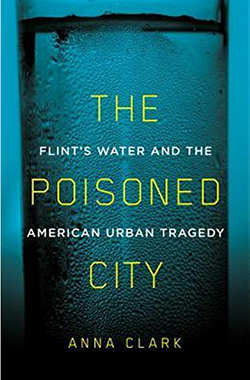 The Poisoned City perfectly exemplifies the miracle of journalism granted the freedom to spill off the pages of periodicals and onto the spacious confines of a book. Clark tells an essential story with enough detail and passion to hopefully inspire action as the Flint water crisis persists, even if it has fallen from the public consciousness due to a manic news cycle and a general lack of empathy.
The Poisoned City perfectly exemplifies the miracle of journalism granted the freedom to spill off the pages of periodicals and onto the spacious confines of a book. Clark tells an essential story with enough detail and passion to hopefully inspire action as the Flint water crisis persists, even if it has fallen from the public consciousness due to a manic news cycle and a general lack of empathy.
The Poisoned City is presented as a historic narrative, allowing the story to weave personal anecdotes with statistics and descriptive passages to bring the story of the Flint water crisis alive and much more personal for the reader. Indeed, it's Clark's skill as a writer in this genre that ensures this book succeeds and flourishes where others have failed to hit the emotional mark.
Fifteen years from now, The Poisoned City could be the definitive account of the Flint water crisis in the annals of planning and urbanism literature. Right now, in 2018, it's the definitive call to action about the ongoing Flint water crisis, far from resolved and in need of devoted and constant media attention and planning expertise. The call to action can be heard far beyond Flint: anywhere systematic failures and neglect of public works persist in creating environmental and public health risks. Buy the book.
Sustainable Nation: Urban Design Patterns for the Future
Douglas Farr
Wiley
April 2018, 400 pages
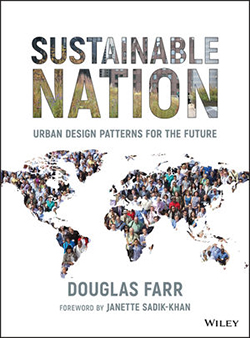 The fundamental question Douglas Farr asks in Sustainable Nation is: What does sustainability look like? Farr answers that question in a variety of ways, with graphs, charts, maps, photographs, schematics, and a host of other visualizations that illustrate the problem of, and solutions to, climate change. Sustainable Nation does not lend itself to reading in one sitting. It's more of a coffee table book, especially enticing for planners who want to combat climate change in their cities but don't know where to start. Farr does his best to touch on absolutely everything a city can do to become just that much more sustainable, from creating community gardens to allowing denser housing types to reducing parking requirements to ripping out highways.
The fundamental question Douglas Farr asks in Sustainable Nation is: What does sustainability look like? Farr answers that question in a variety of ways, with graphs, charts, maps, photographs, schematics, and a host of other visualizations that illustrate the problem of, and solutions to, climate change. Sustainable Nation does not lend itself to reading in one sitting. It's more of a coffee table book, especially enticing for planners who want to combat climate change in their cities but don't know where to start. Farr does his best to touch on absolutely everything a city can do to become just that much more sustainable, from creating community gardens to allowing denser housing types to reducing parking requirements to ripping out highways.
In visualizations and essays—by Farr and a host of distinguished guest writers—Farr lays out a rich menu for planners to choose from. His chapters cover hard urbanism, like buildings and streets, as well as soft but crucial issues like governance, economic sustainability, and street life. All along, Farr seeks to illustrate "patterns" of preferred outcomes that individual communities can use as guidelines, often to overcome local resistance or fear of change. Farr writes, "local actors walking around their neighborhoods using patterns as a portal into a preferred future can navigate their neighborhood toward that 'more perfect' end state." If every stakeholder could read Sustainable Nation and see what a green, carbon-lite future looks like, we'd probably get there much more quickly. Buy the book.
Walkable City Rules: 101 Steps to Making Better Places
Jeff Speck
Island Press
October 15, 2018, 312 pages
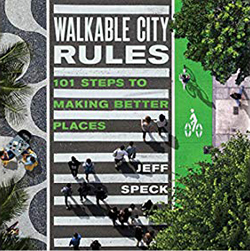 Walkable City Rules makes no secret that it's a follow up to Jeff Speck's previous work in Walkable City. In fact, on the second page of the introduction, Speck writes that the new book is "an effort to weaponize Walkable City for deployment in the field." While the purpose of Walkable City is to win people over to the cause, the purpose of Walkable City Rules is to get things built, explains Speck.
Walkable City Rules makes no secret that it's a follow up to Jeff Speck's previous work in Walkable City. In fact, on the second page of the introduction, Speck writes that the new book is "an effort to weaponize Walkable City for deployment in the field." While the purpose of Walkable City is to win people over to the cause, the purpose of Walkable City Rules is to get things built, explains Speck.
The success of Walkable City in winning people to the cause deserves a lot of credit for the many real-world opportunities for a more walkable public realm presented to planners today. The ongoing challenge arises in making sure walkability is done well and at scale. It's easy to talk the walk, but not always to walk the talk. Despite all the inroads made by Speck and other walkability advocates, the obstacles to a truly walkable approach to town and city planning is still faced with massive obstacles and numerous opponents.
Thus, the necessity of the new approach of Walkable City Rules.
While Speck hopes (and directly suggests) that readers will read the book from cover to cover (and perhaps open an urban design consultancy afterward), the book is designed to provide reference points on highly actionable, specific ideas. This is a book that the reader can randomly flip open and read for ideas when passing the time, stuck in a rut, or looking for inspiration. Like any good index of ideas and references, Walkable City Rules is for people looking to push beyond mere regulatory conformity into best practices and creative solutions.
Perhaps the aspect of the book that most successfully marries the inspiration and the practical is the roster of cities and communities that make the list of case studies. Des Moines, Iowa: Lowell, Massachusetts; Lancaster, Pennsylvania; and Fort Lauderdale, Florida, among many others, are granted just as much ink as the usual suspects in New York and Portland. Speck's 101 rules for making a walkable city, organized into 19 sections, promotes one big idea above all the rest: any city can take steps to create a more walkable environment, and right now. Buy the book.

Planetizen Federal Action Tracker
A weekly monitor of how Trump’s orders and actions are impacting planners and planning in America.

Chicago’s Ghost Rails
Just beneath the surface of the modern city lie the remnants of its expansive early 20th-century streetcar system.

Amtrak Cutting Jobs, Funding to High-Speed Rail
The agency plans to cut 10 percent of its workforce and has confirmed it will not fund new high-speed rail projects.

Ohio Forces Data Centers to Prepay for Power
Utilities are calling on states to hold data center operators responsible for new energy demands to prevent leaving consumers on the hook for their bills.

MARTA CEO Steps Down Amid Citizenship Concerns
MARTA’s board announced Thursday that its chief, who is from Canada, is resigning due to questions about his immigration status.

Silicon Valley ‘Bike Superhighway’ Awarded $14M State Grant
A Caltrans grant brings the 10-mile Central Bikeway project connecting Santa Clara and East San Jose closer to fruition.
Urban Design for Planners 1: Software Tools
This six-course series explores essential urban design concepts using open source software and equips planners with the tools they need to participate fully in the urban design process.
Planning for Universal Design
Learn the tools for implementing Universal Design in planning regulations.
Caltrans
City of Fort Worth
Mpact (founded as Rail~Volution)
City of Camden Redevelopment Agency
City of Astoria
City of Portland
City of Laramie





























